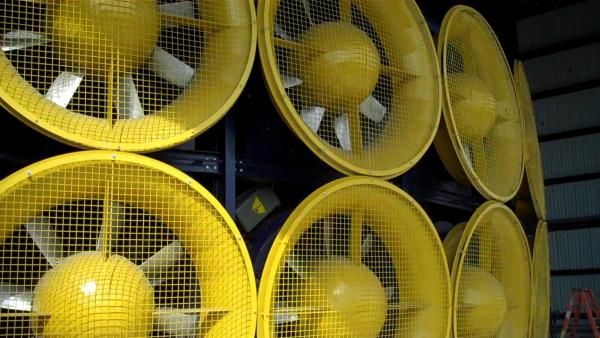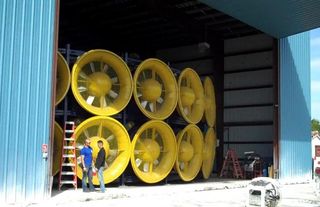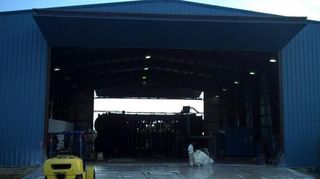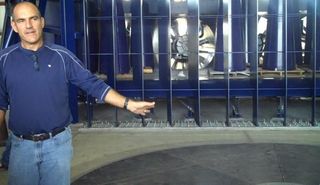
WoW! See the New 'Wall of Wind' Hurricane Simulator

SWEETWATER, FLA. — Looking up at the "Wall of Wind" quickly puts a hurricane's roaring winds into context.
At a sky-blue airplane hangarlike building in this town outside Miami, a raised door reveals an enormous bank of what look like jet engines, painted yellow and stacked in two rows of six, hugging the edge of the hangar.
Most people have ridden inside a car going 74 mph (119 kph), the speed at which a storm outgrows the tropical storm classification and becomes a hurricane. But that experience is so commonplace today that it's easy to forget how fast that really is.
But at the Wall of Wind — WoW for short, an acronym that actually fits — the generators of that speed tower over you in the form of a bank of giant fans.
The Wall of Wind is still being built, but when finished, it will mimic the force of a major hurricane (Category 3 or higher) by sucking air into the fans and blasting winds of up to 140 mph (225 kph) at new, wind-resistant housing prototypes inside the hangar. For good measure, the wind engineering team at Florida International University, where the wind lab is located, will spray rain and blast debris at the prototypes to make sure they are up to snuff.
"The idea of the Wall of Wind was to start for the first time ever doing full-scale testing," said Stephen Leatherman, chairman of the International Hurricane Research Center and a Wall of Wind team member.
After taking an inside look at the National Hurricane Center, OurAmazingPlanet got an early peek at the Wall of Wind. So as not to sound like a demolition derby run by scientists, the facility's official name is the Laboratory for Wind Engineering Research. The Wall of Wind is backed by the insurance industry with matching funds from the state of Florida.
Sign up for the Live Science daily newsletter now
Get the world’s most fascinating discoveries delivered straight to your inbox.
The idea is that the lab will be like a crash-test dummy for hurricanes and lead to new safety innovations much like test dummies led to airbags. At a similar lab at Clemson University in South Carolina, engineers tested a new, stronger nail, called the HurriQuake Nail, which has the potential to save lives during a hurricane or an earthquake. Engineers will research similar hurricane innovations at the Florida lab, where they attempt to tear off roofs, snap cables, collapse walls, blow out windows and flood buildings. Solar panel companies are even keen to test their products there.
The Florida engineers hope their experiments will add some scientific heft to home retrofitting and new-building design, something that's on the minds of coastal residents during this 2011 Atlantic hurricane season, which has been a doozy and still has 30 days left.
So far, the season has seen six hurricanes and 17 named storms(storm names are given when a system becomes a tropical storm). With major hurricanes expected to increase due to climate change, vulnerable areas like South Florida are in desperate need of new hurricane-survival technologies.
"We're not saying we can stop damage from at Category 5 hurricane, but we can stop a Category 3, and that's 85 to 90 percent of the damage," Leatherman said.

We need a test house. Volunteers?
Before the Wall of Wind, researchers at Texas Tech University in Lubbock tried using a C-130 airplane to simulate hurricane winds on a house. They backed the plane up to a trailer and cranked the engines up to 120 mph (193 kph) to see what would happen.
"Well, it did a lot of damage, but the other problem is it melted part of the trailer," Leatherman said. "That's not quite what hurricanes do."
In 2004, the Florida wind lab built its first Wall of Wind, a portable two-fan system, to better simulate a hurricane's winds and the costly damage it can cause. The double-decker rig was also capable of blowing wind at 120 mph while spraying rain. The only problem was that the engineers needed a house to point it at. [The Costliest Hurricanes in History]
Leatherman persuaded the mayor of Sweetwater, about 10 miles (16 kilometers) from Miami, to let him test their fans on a real house. They settled on the house of a 90-year-old man who had recently died. With no heirs, the man's house had gone untouched; fully furnished, drapes up, a set table, glasses still in the cabinets, pocket change on the dresser. A perfect test house that the man had even claimed was hurricane-proof. The wind engineers showed it most certainly was not.
"Sure enough, we got some real action," Leatherman said.
The home's asphalt shingles peppered the neighbor's yard. Windows that had been taped in an X-pattern with masking tape were blown right out, showing the worthlessness of that precaution. Blown-open windows and doors created a wind tunnel effect that sucked the ceiling to the floor.
"I mean, it was tremendous damage." Leatherman said, standing atop the old Wall of Wind. "That was super, I had so much fun."
The lab gradually upgraded to bigger fan systems and will soon crank up the 12-fan behemoth. The new Wall of Wind will run experiments in a smaller, more controlled environment at much less cost than bigger wind labs at other universities.
The engineers are anxious to flip the 'on' switch, but the anticipated ferocious damage will have to wait. The hangar still needs a new front door, and sound protection has to go up around the compound's perimeter so the neighbors won't feel as if they are living next to an airplane runway.

Full-diesel damage
The Wall of Wind is not to be confused with a wind tunnel, which is a confined tunnel that blows wind over scaled-down houses, some as small as a bird house. While a useful tool, it doesn't tell the whole story, Leatherman said.
"We have to actually simulate the way wind interacts with the environment," Leatherman said.
To do that, the wind engineers will do everything in their power to find a structure's weakest link. The new facility will accomplish that by testing full-size windows, doors and terra cotta tiles — a South Florida staple — but on small houses.
The hangar that houses the new Wall of Winds is outfitted with scientific instruments so that the engineers can quantify the damage. A water-injection system simulates rain. Air cannons can fire debris, "if we really want to punish something," Leatherman said.
Each of the 4,000-volt electric fans, painted blue like the inside of the hangar, run on 700 horsepower.
"Before all this was planned, we had to check with FP&L [Florida Power & Light Co.] to make sure they had the capacity to power us," said Walter Conklin, Wall of Wind project manager.

The wind, rain and debris will be aimed at a turntable that will spin the small houses.
The new turntable will save the backbreaking chore of manually turning houses, Conklin said.
"When we're out there testing on the 6-fan, we actually have to go out there with manual jacks, lift it up, stop the test and turn it," Conklin said. "It might take us upwards of 20 or more minutes to turn a specimen and get it exactly where we want it."
Debris from those past experiments was swept behind the new hangar, as if someone had tried to clean up the place before the tour, much to Leatherman's disappointment.
"These are treasures," Leatherman said, walking past the few battered huts, topped with the latest in wind-resistant roofs, still on the grounds. "We've got to do a little bit more damage around here."
You can follow OurAmazingPlanet staff writer Brett Israel on Twitter: @btisrael. Follow OurAmazingPlanet for the latest in Earth science and exploration news on Twitter @OAPlanet and on Facebook.












